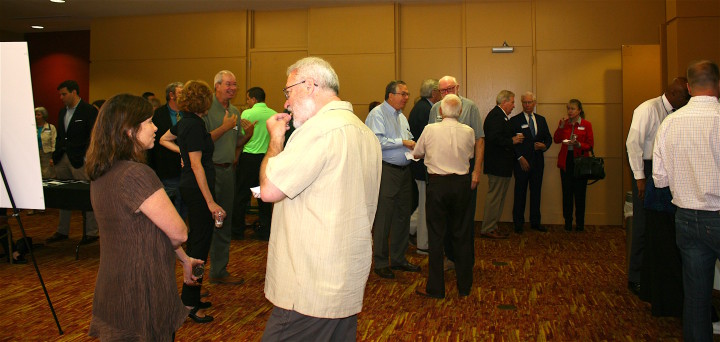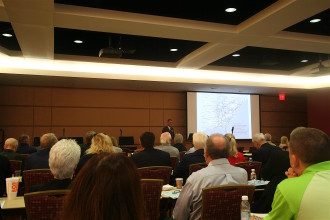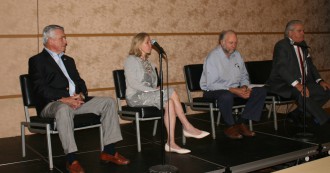Even the mightiest institutions must reinvent themselves in the face of new economic realities. That’s the situation for Western North Carolina’s railroad industry, which finds itself on the fast track to major changes as demand for industry mainstays like coal diminishes.
While major carriers such as Norfolk Southern and CSX reconfigure their regional infrastructure in response to changes in cargo, locally based rail companies are on the rise in WNC. At the same time, efforts to re-establish regular passenger rail service to the Asheville area continue.
Amid these trends, community and business representatives from across the rail industry gathered in Asheville on Sept. 22 for the Railroads & Regional Economic Development Conference. Organized by the WNC Rail Committee, the conference revealed some hints of how railroads may adapt to changing times.
Whistle stops
Over the past two years, both CSX and Norfolk Southern — the region’s two largest railroad operators — downgraded their major lines through WNC to secondary status, citing a need to cut costs.
“Basically, it went from about one [train] an hour that came through Marion, to one a day,” says Freddie Killough, co-chair of the WNC Rail Committee. “That was the writing on the wall.”

In addition to reducing freight operations, the downgrades also put an end to special leisure events like the North Carolina Transportation Museum’s excursion line between Spencer and Asheville, a popular attraction for tourists and locals alike. “The excursions can no longer run in WNC, because the speed on the line has been reduced to 25 miles per hour,” Killough says.
Changing tracks
The WNC Rail Committee, founded in 1995 with the goal of reinstating passenger rail service to the mountains, met in March 2016 to reorient itself to the new realities of rail in the area. (See “WNC Rail Corridor Committee Hatches New Strategy,” April 7, 2016, Xpress)
According to former Rep. Ray Rapp, the committee is focused on improving and expanding freight rail service, increasing tourism-based operations in the region, and re-establishing a passenger rail connection between Asheville and eastern North Carolina. “We’ve got to change our thinking about railroads, what they do, how they can be an integral part of our economic development strategies,” says Rapp, who serves as the committee’s co-chair.
The Sept. 22 conference, he continues, represents a chance to “plant the seeds for some thoughtful, long-range planning about an integrated transportation system for WNC. It’s a look forward to see how we can develop a system that is fast, efficient, environmentally sound and more broad than simply building highways.”
Meeting of the minds
Asheville Mayor Esther Manheimer kicked off the conference with comments on Asheville’s emphasis on multimodal transportation. “We hope to be less reliant on cars moving forward,” she said. “Rail is an important part of that process.”

Paul Worley, the former director of the North Carolina Department Of Transportation’s Rail Division, and current director of strategic initiatives for engineering consultancy Mott MacDonald, provided a look at the railroad’s recent history. “There’s a lot of ‘whys’ when it comes to the state of railroads,” Worley noted, adding that the state has been active in preserving abandoned lines since the late 1980s. DOT currently owns over 100 miles of rail, which it will hold until a viable private investor can be found.
Intermodal transfer stations that provide access to rail service through a combination of trucking and trains are an important trend, Worley said. Sierra Nevada Brewing Co., he pointed out, built such a facility along the rail line in Fletcher to service its Mills River manufacturing plant. Worley believes there’s still a lot of opportunity in WNC if local representatives and businesses can prove to rail companies that the necessary workforce is present and the investment in the region is viable.
Davey & Goliath
Representatives from several freight operators also addressed the conference, beginning with the biggies: CSX and Norfolk Southern. Jim Van Derzee, development manager for CSX, acknowledged that this area remains an important corridor for the company but noted that a decline in coal shipments, coupled with the difficulty of maintaining a railway through the mountains, led the company to reduce traffic on its line from Erwin, Tenn to Bostic, N.C. in order to cut costs.
Norfolk Southern’s Grant Cothran, meanwhile, highlighted the energy efficiency of intermodal development, noting that trains offer a 70 percent reduction in greenhouse gases over trucking. “One freight train takes an average of 300 trucks off the road.”
The company’s S Line runs through Asheville, extending north through Madison County and east through Marion. While Norfolk Southern doesn’t plan to sell the line, the materials the company transports are changing, Cothran noted. Between 2010 and 2016, coal went from 23 percent of the company’s freight material on the S Line to 13 percent, while intermodal containers currently comprise more than half of the material the company transports through the region.
“Intermodal transport is the largest growing sector of our business,” Cothran said, noting that nearby Charlotte has become an intermodal hub. “WNC is very well-positioned to leverage the system we’ve built.”

Darl Farris, Matt Gedney and Carl Hollowell spoke on behalf of regional short-line companies, which generally operate on the first and last few miles of freight lines, connecting national freight carriers to the businesses they serve. As freight shipping has declined and railroads have downgraded service to save costs, short-line railroads have picked up some of the slack, with 550 short-line railroads now operating in the United States.
Farris, the general manager for Canton-based Blue Ridge Southern, spoke of the connections short lines have with the communities they serve. “We’re flexible and predicated on customer service,” Farris said, pointing to the company’s relationship with large customers like Evergreen Paper in Canton and Sierra Nevada.
Blue Ridge Southern, like CSX and Norfolk Southern, is also preparing for a decline in coal shipments as Duke Energy transitions its Lake Julian power plant to natural gas in the coming years. “Losing this segment of business will result in a significant loss of revenue for [Blue Ridge Southern],” says Farris, whose company operates the rail line that brings coal to Duke’s plant. “Our commercial team is working hard to replace this impending loss by growing business opportunities with existing customers and potential new customers.”
Mixing business with pleasure
The conference’s afternoon session began with a discussion of excursion trains — specialty outfits that offer residents and tourists a glimpse into railroads’ storied past — and their potential to affect the future of the industry. Robert Van Kamp, creator and producer of the “Great Scenic Railway Journeys” documentary series, said the excursion industry has grown significantly in the past 25 years, with more than 500 companies in the United States alone. These businesses generated over $100 billion in economic impact nationwide, he added, even though few excursion trains make much money and many operate as nonprofits.
David Huskins of the Great Smoky Mountains Railroad in Bryson City spoke of the important role excursions play in preserving cultural heritage, while noting that the business has a $46 million impact on Swain County annually.
Rocky Hollifield of the Craggy Mountain Line in Woodfin said since its founding in the mid-1990s, his company has grown from a pipe dream to a multifaceted business. “I remember many years ago, walking down the mountain, just praying and asking the Lord to make a way for us to somehow save this track,” he recalls. “Years ago, people laughed at me and said I was crazy for doing this.”
Now, Craggy serves about 3,000 passengers a year on its 3.5-mile track. Trips run every weekend and on holidays. The excursion operation played a role in local investors’ recent decision to approve funding for the future Woodfin Greenway and Whitewater Wave along the French Broad River, Hollifield says.
Government business
Examples like Craggy show that the rail industry can still play an important, though evolving, role in WNC’s economic growth and future, says Rapp. To make it happen, government officials from the municipal to federal levels must prioritize infrastructure investments. “There’s one thing I learned when I was in the legislature — we can talk about a lot of things, but until we get down and talk about the costs of it, and who’s going to pay for it, the conversations are not serious,” he says.
The conference featured several such conversations with state legislators, including Sens. Jim Davis, chair of the Senate Transportation Committee, and Terry Van Duyn, as well as Reps. John Torbett and John Ager, who both sit on the House Transportation Committee.
Torbett pointed to the need to fund a variety of transportation initiatives and encouraged residents to bring their ideas regarding transportation to legislators’ attention. Ager, meanwhile, affirmed his support for getting “rail back to prominence” in the Asheville area.
Van Duyn, a Chicago native, said that “trains are in our DNA.” She praised Sierra Nevada for its $1 million investment in the Fletcher intermodal transfer station and noted that local rail lines run through areas that were hit hard by the 2008 recession. “Rail is one chance to revitalize these communities,” Van Duyn said.
Davis praised the Great Smoky Mountains Railroad’s revitalizing effects on Bryson City but stopped short of advocating for additional state funding for rail initiatives unless data supports the investments. “Show me the numbers,” Davis said. “I want to invest money, not spend it. We must balance funding with our transportation needs.”
Road to passenger rail
The conference ended with the most uncertain aspect of the future of local railroads: the likelihood of restoring regular passenger rail service to WNC. Cheryl Collins of the NCDOT spoke on the steps needed to implement a thruway bus service, which could link Asheville to Amtrak stations in Salisbury.
Collins outlined the methodology her department used to forecast several Amtrak bus service models from Salisbury to Asheville and provided a breakdown of costs between Alternative 1A, which would feature a daily connection to Amtrak’s Carolinian and Piedmont lines, and Alternative 1B, which would increase Asheville service to two trips a day, but without connections to the Carolinian line. Collins added that the next update on the process won’t come until spring 2018, since Amtrak and other parties have not fully evaluated the costs of getting the service up and running.
A key part of the passenger rail equation moving forward, says Rapp, is getting municipalities, current rail right-of-way owners and Amtrak on the same page. “If they can see a way that it’s profitable, they may be able to be convinced … to restore that aspect of the tourism industry in WNC.”
Down the line
The shifting priorities of younger generations, Rapp says, may also hold the key to how the rail industry responds to changes happening today. “I look at my son, who just turned 25 — he doesn’t think about cars the way my generation does,” he says. “Having other modes of transportation, so he can sit with his laptop and work, is more important to him.”

In this sense, says Blue Ridge Southern’s Farris, rail offers the perfect complement to many residents’ modern-day concerns and priorities. “The future of the rail industry in WNC is one of conscientious growth: As the population in WNC swells, the basic needs of a consuming public will grow with it,” he says. “Generally speaking, freight trains provide these needs in a manner much more appealing to the environmentally conscious modern American. Community growth, supported by rail where feasible, is a much more prudent way to support growth as active eco-stewards.”
Hollifield, meanwhile, remains optimistic on the future of the local railroad industry. “In the rail business, I’ve learned that a ‘no’ today, next week could be a ‘yes,’” he says. “Just like any business, everyone has to come out at the end of the day with a profit.”



Very interesting to see other people’s thoughts on this, Max – and great job as usual in laying it out. When I was stationed in Germany over 30 years ago, rail was the best deal going – most stations were in the city and town centers, and I recall making the 30 mile trip to Braunschweig from the little town I was stationed in for something like 2 bucks – not having to drive and park, and being able to easily walk to the best shops and restaurants. Many little towns had a station and from those you could link with buses and taxis to get about anywhere. Now I understand that Germany privatized their rail system and everything “unprofitable” has been shut down and/or removed.
My wife, daughter and I have taken several rail trips on vacation using AMTRAK – it is great if you are going to NYC, Washington DC or any of the towns along the 2 routes – there are only two North/South routes on the East Coast now – NYC to New Orleans and NYC to Miami. To use the Western lines, you have to get to Chicago or St Louis by another means.